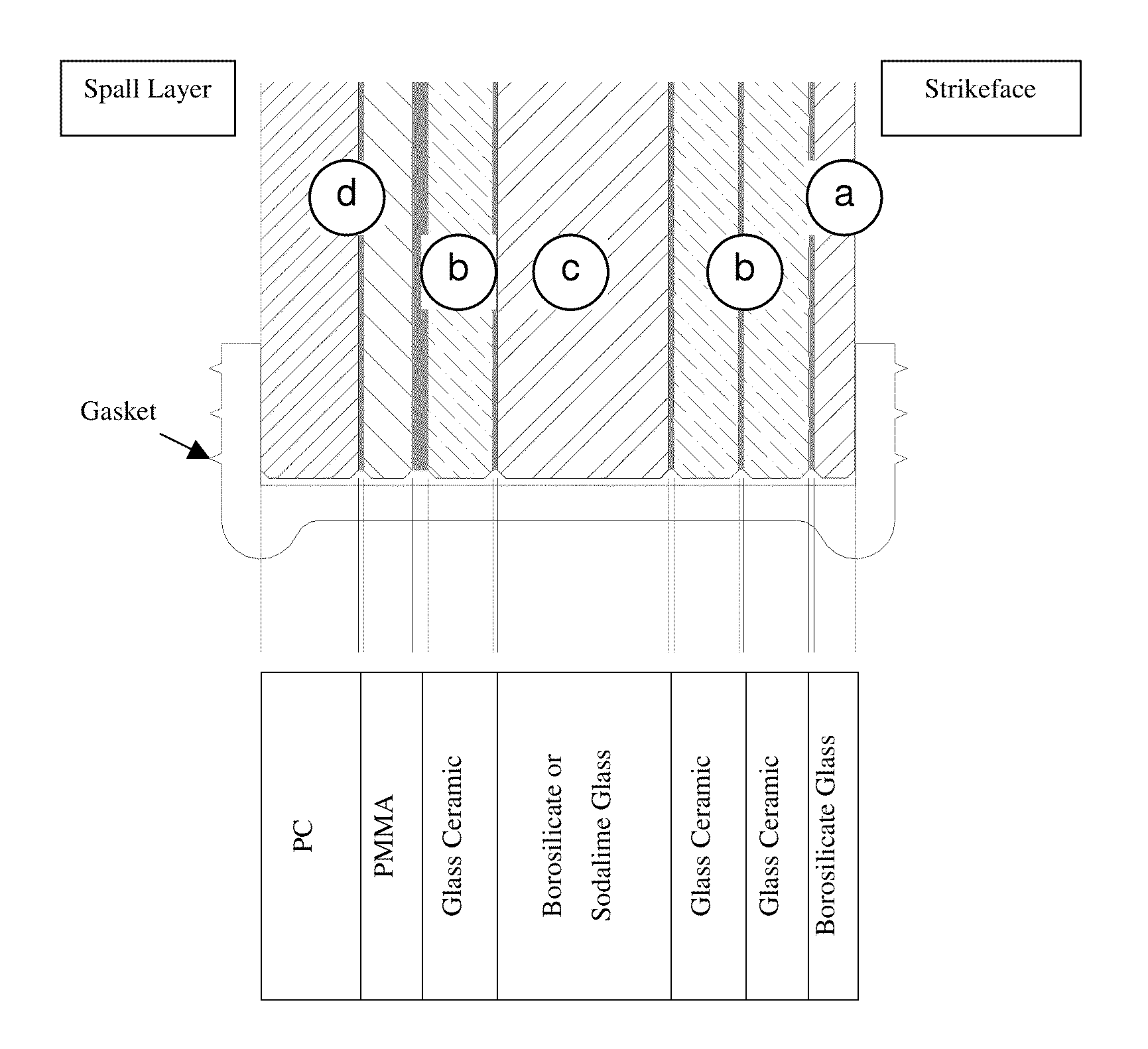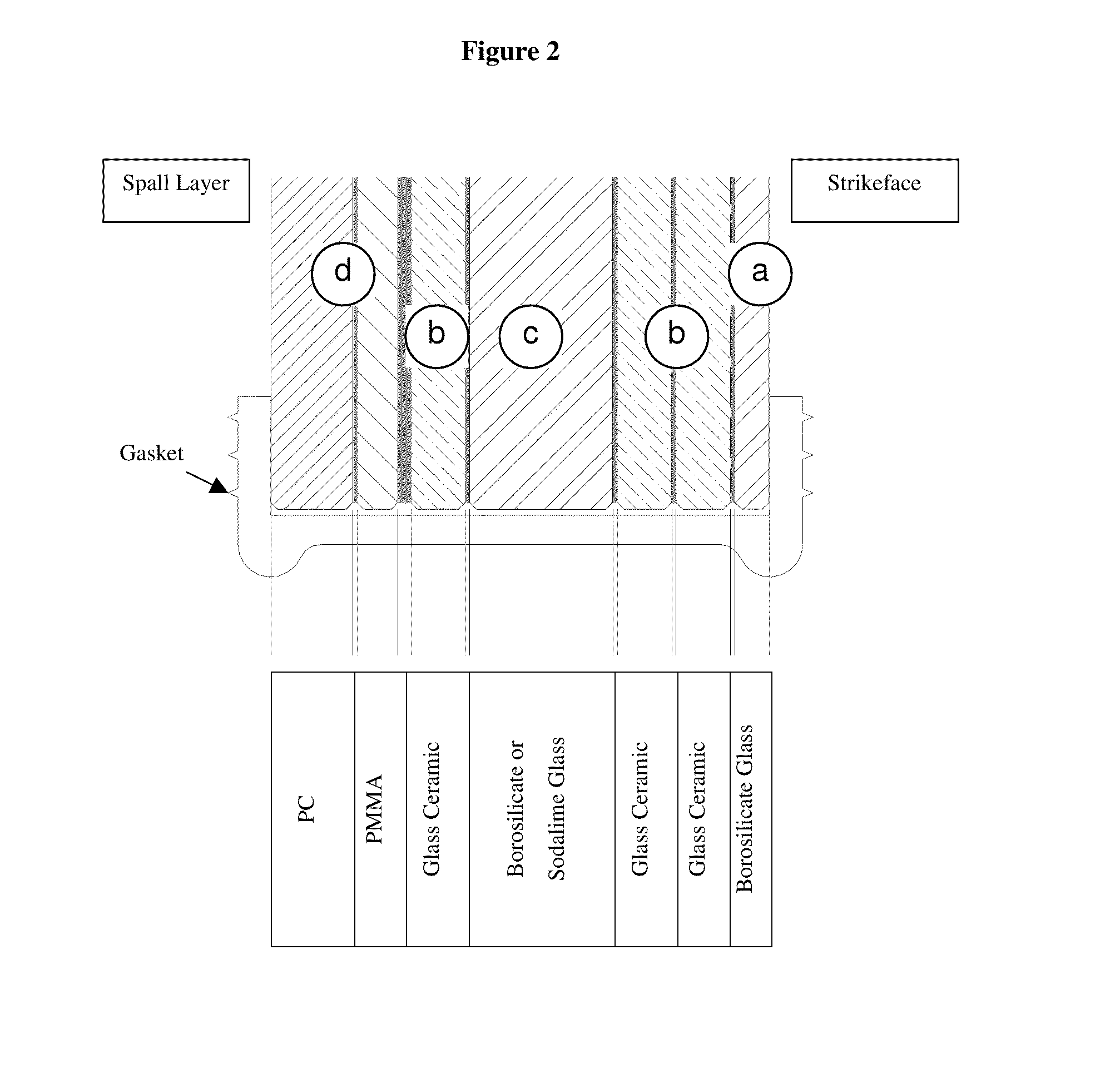Lightweight transparent armor window
a transparent, armor window technology, applied in protective equipment, transportation and packaging, synthetic resin layered products, etc., can solve the problems of high cost per square inch of these systems, and inability to meet the requirements of large-scale production
- Summary
- Abstract
- Description
- Claims
- Application Information
AI Technical Summary
Benefits of technology
Problems solved by technology
Method used
Image
Examples
example 1
[0082]The following arrangement of laminate layers provides protection against 0.30 cal. AP-M2 projectiles at speeds of up to 2750 fps. The window, without frame, exhibits an areal density of 30 psf or less.[0083]Strike face: SCHOTT BOROFLOAT with a thickness between 4 mm to 6 mm[0084]1st Interlayer: 25 mil PU (Polyurethane) film (Huntsman PE501 or similar)[0085]1st Layer (b): SCHOTT ROBAX Glass Ceramic with a thickness between 7 mm to 8 mm[0086]2nd Interlayer: 25 mil PU film (Huntsman PE501 or similar), or 25 mil PVB (Polyvinylbutyral) film[0087]2nd Layer (b): SCHOTT ROBAX Glass Ceramic with a thickness between 7 mm to 8 mm[0088]3rd Interlayer: 25 mil PU film (Huntsman PE501 or similar), or 25 mil PVB film (Polyvinylbutyral)[0089]3rd Layer (c):[0090]Option A: single-layer SCHOTT BOROFLOAT with a thickness between 18 mm to 21 mm[0091]or[0092]Option B: double-layer SCHOTT BOROFLOAT with a thickness of each individual layer between[0093]9 mm to 11 mm, bonded with 25 mil PVB or PU film...
example 2
Ballistic Test Results
[0101]Small, multi-layer test coupons (100 mm×100 mm) are mounted on a 12″×12″×12 mm thick polycarbonate backing. The samples are tested in a configuration similar to the one shown in FIG. 9. The test projectile is 0.30 cal. AP-M2 at the indicated nominal speed (2250 fps or 2750 fps). Based on the test results, the design described in Example 1 is derived combining the two multi-layer sequences marked with an asterisk in Table 2 to accommodate for scaling.
TABLE 1ABallistic Test Results - 2250 fps impacts by 0.30 cal. AP-M2ShotWeights (Grains)Velocity Data (ft / sec)PenetrationNumberProjectilePropellantNo. 1No. 2AverageDescription / Pen. into PB9-17564162.834.4228322812282No Penetration9-17565163.434.4225922592259No Penetration9-17566163.134.4225422542254No Penetration9-17567163.534.4222222222222No Penetration9-17568163.334.4228422842284No Penetration9-17569163.434.4225722572257No Penetration9-17570163.634.4228122802281No Penetration9-17571163.434.4226822672268No Pe...
example 3
Multi-Hit Example
[0103]Three 500 mm×500 mm test coupons for multi-hit testing are prepared, and tested against an 0.30 cal. AP-M2 round at nominal 2750 fps; the shot pattern is a 120 mm triangle, the shot sequence is 12 O'clock, 4 O'clock and 8 O'clock. The nominal areal density of the samples is 29 psf; due to slight variations in the thickness of the individual glass and glass-ceramic layers, the areal density of the samples as manufactured is 29.7 psf (samples 1 and 2) and 30 psf (sample 3).
The samples have the following structure:
500 mm × 500 mm, edges sealed, framelessSample 1Strikeface6 mm BorofloatInterlayerHuntsman PE-501 - 25 milPly 018 mm Robax Glass-ceramicInterlayerHuntsman PE-501 - 25 milPly 028 mm Robax Glass-CeramicInterlayerHuntsman PE-501 - 25 milPly 0321 mm BorofloatInterlayerHuntsman PE-501 - 25 milPly 048 mm RobaxInterlayerHuntsman PE-501 - 75 milSpall-Layer9 mm PMMA laminated to9 mm PC (Lexan)Sample 2Strikeface6 mm BorofloatInterlayerHuntsman PE-501 - 25 milPly ...
PUM
| Property | Measurement | Unit |
|---|---|---|
| thickness | aaaaa | aaaaa |
| thick | aaaaa | aaaaa |
| thick | aaaaa | aaaaa |
Abstract
Description
Claims
Application Information
 Login to View More
Login to View More - R&D
- Intellectual Property
- Life Sciences
- Materials
- Tech Scout
- Unparalleled Data Quality
- Higher Quality Content
- 60% Fewer Hallucinations
Browse by: Latest US Patents, China's latest patents, Technical Efficacy Thesaurus, Application Domain, Technology Topic, Popular Technical Reports.
© 2025 PatSnap. All rights reserved.Legal|Privacy policy|Modern Slavery Act Transparency Statement|Sitemap|About US| Contact US: help@patsnap.com



